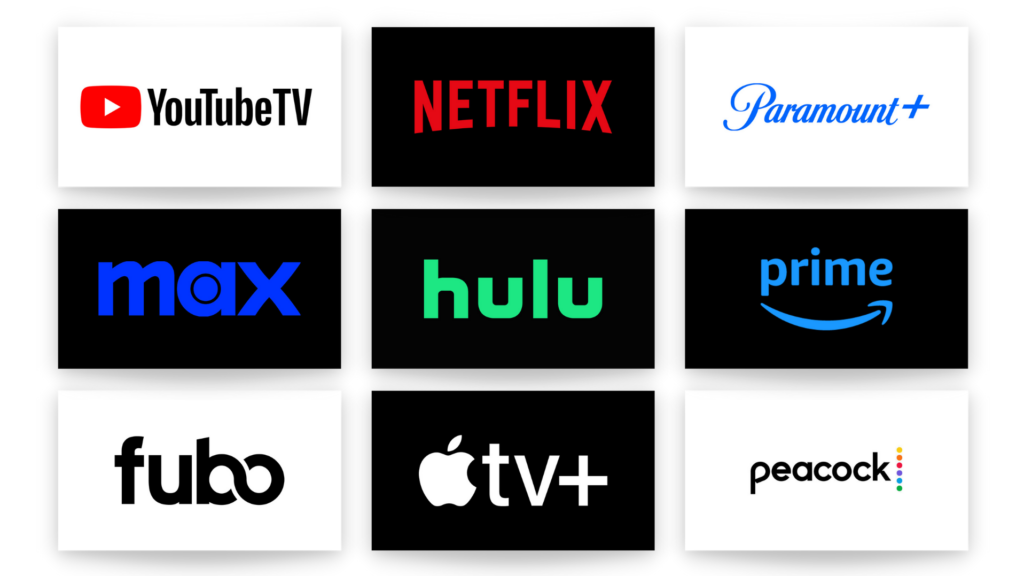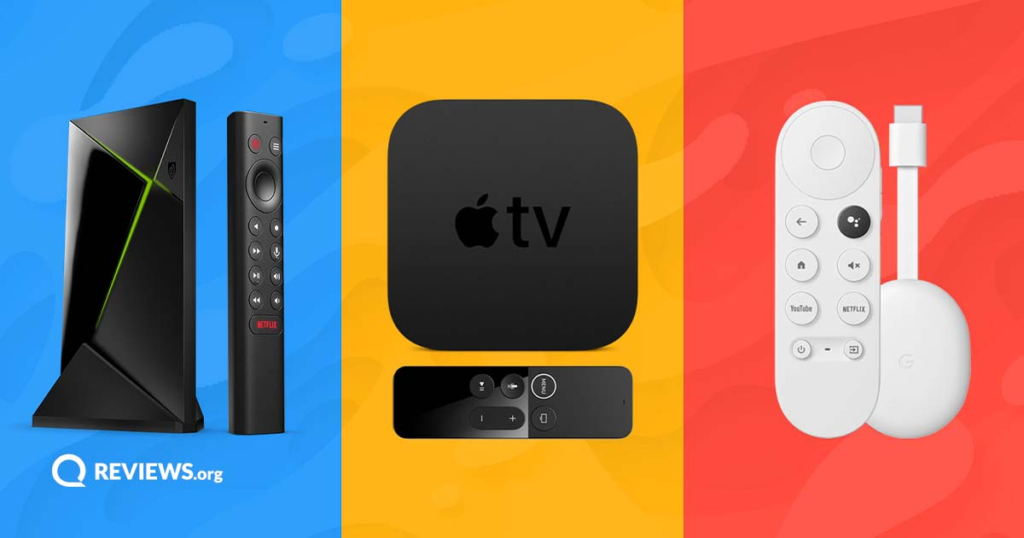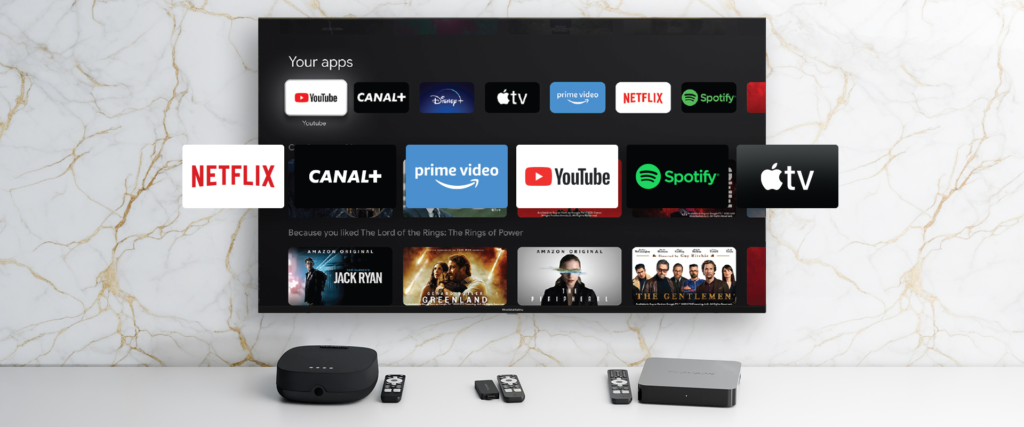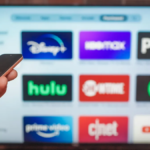
photo credit: NPR
Streaming devices are hardware that allow you to access and view content from streaming services on your television, computer, or mobile device. Amazon Prime Video allows up to 3 streams at a time but limits simultaneous streaming of the same title to 2 streams.
Table of Contents
Introduction
Streaming has become an essential part of entertainment, but with so many services available, choosing the right one can be overwhelming. With an abundance of options—each offering unique content, features, and pricing—making the right choice often comes down to one crucial factor: compatibility with your devices.
Whether you’re using a smartphone, tablet, gaming console, or smart TV, how well a service works with your device may make or ruin your experience.
In this post, we will examine which streaming services are accessible on the majority of gadgets to guarantee a flawless viewing experience. To assist you in selecting the service that best suits your setup, we’ll also look into the device support of several services, ranging from popular ones like Netflix and Amazon Prime Video to more niche ones.
The Importance of Device Compatibility in Streaming
When selecting a streaming service, it’s essential to consider device compatibility, as it can significantly impact your viewing experience. In today’s digital age, people use a variety of gadgets, and their preferred ways of consuming content can vary widely. Some people choose to watch on a smart TV in the living room, while others prefer to watch on a smartphone or tablet when they’re on the commute.
You may continue where you left off on any device, thanks to the unmatched ease of quickly accessing content across platforms. Versatility, which enables you to switch between devices based on your needs soon, whether you’re at home, at work, or on the road, is another benefit of having a wide variety of device alternatives.
A streaming service that is compatible with several devices makes more accessibility possible. Because of interoperability across a range of devices, users are not limited to a particular platform, making it easier to consume content without needing to buy specialized equipment. This is especially important for households with many individuals, each of whom may have distinct gadget preferences.
The more devices a streaming service supports, the easier it is to meet the viewing needs of all household members.
What Are Streaming Devices?

Photo credit: Reviews.org
Streaming devices are hardware that allow you to access and view content from streaming services on your television, computer, or mobile device. These devices play an essential role in making streaming services accessible and enjoyable. Here are the most common types of streaming devices:
Smart TVs
Several streaming services, including Netflix, Amazon Prime Video, Hulu, and others, have applications integrated into contemporary smart TVs. These devices let you broadcast video straight from the TV’s operating system without the need for extra hardware. Smart TVs often support 4K and HD content and offer an excellent viewing experience.
Gaming Consoles
Gaming consoles like the PlayStation 5, Xbox Series X, and Nintendo Switch are not just for gaming—they’re also powerful streaming devices. They support a wide range of streaming apps, allowing you to watch movies and shows in high quality, and they offer features like voice control and remote functionality.
Streaming Sticks and Boxes
Several streaming services are accessible through streaming sticks (like Roku, Amazon Fire TV Stick, and Google Chromecast) and streaming boxes (like Apple TV and NVIDIA Shield TV) that connect to your TV’s HDMI connection. These gadgets, which usually include remote controllers and some that accept voice commands, provide a quick and easy method to stream media to your TV.
Smartphones and Tablets
Tablets and smartphones are standard streaming devices, particularly for viewing while on the go. Mobile applications from services like Netflix, YouTube, and Hulu make it simple to stream content from any location. As an extra convenience, many providers also let you download content for offline viewing.
Web Browsers
For users who prefer watching on a computer, web browsers (like Google Chrome, Safari, or Microsoft Edge) can access streaming services. Most platforms offer browser-based streaming for users on desktops or laptops, allowing flexibility for users who prefer larger screens without the need for additional hardware.
Every one of these streaming devices helps to create a variety of watching experiences so that customers may select the one that best suits their lifestyle. These gadgets make sure that streaming services are always available, whether you’re viewing on a large screen, a game console, or a mobile device.
Top Streaming Services and Their Device Compatibility

photo credit: Thompson
Amazon Prime Video
One of the most flexible services on the market is Amazon Prime Video, which stands out for supporting a large number of streaming devices. It works with game consoles like the PlayStation and Xbox as well as well-known streaming devices like Fire TV, Roku, Apple TV, and Google Chromecast. You can stream material on almost any device because it is also accessible on tablets, web browsers, and smartphones (iOS and Android).
Beyond basic video streaming, Amazon Prime Video offers additional features like offline viewing. This makes it an excellent option for travel or places with spotty internet because it enables users to download films and television series on their devices and enjoy them later without an internet connection. Amazon Prime Video’s status as a leading candidate for device compatibility is cemented by its versatility across streaming devices and the addition of new features.
Netflix
Netflix, one of the most widely recognized streaming services, offers impressive compatibility with a variety of streaming devices. It is available on almost all smart TVs, gaming consoles (PS4, PS5, Xbox Series X/S), streaming sticks (like Roku and Amazon Fire TV Stick), and mobile devices (iOS and Android). This broad availability ensures that users can enjoy Netflix’s vast library of content on almost any device, anytime.
With its ongoing global device support expansion, Netflix is now available to consumers in almost every location. The app offers high-quality streaming, including 4K material on compatible devices, and is optimized for a variety of platforms. Many people use Netflix because of its wide range of device compatibility, which allows it to fit in with a variety of home configurations.
Disney+
Disney+ has made significant strides in supporting streaming devices, offering access on major platforms such as smart TVs (Samsung, LG, Sony, Vizio), gaming consoles (PS4, PS5, Xbox), and streaming sticks (Roku, Apple TV, Amazon Fire TV). It also supports mobile devices (smartphones and tablets) and web browsers, allowing users to access its content from nearly anywhere.
However, while Disney+ supports a wide range of devices, there are some limitations when it comes to features like 4K and HDR. Specific older devices may not support these higher-quality formats, limiting the full potential of Disney+ content for some users. Despite these limitations, its broad availability across major platforms ensures that most users will have a great experience with Disney+.
Hulu
Hulu is excellently compatible with smartphones, smart TVs, streaming sticks (like Roku, Amazon Fire TV, and Apple TV), and gaming consoles. Its integration with various platforms makes it a versatile option for viewers who want to be flexible in how and where they watch content.
Hulu is similar to Netflix and Amazon Prime Video in terms of device compatibility, albeit it might not be as accessible on some older devices. Along with improving its compatibility with newer devices, Hulu has been offering services like Hulu + Live TV on platforms that support it. For the majority of customers, Hulu provides a good selection of alternatives, even though its compatibility may not be as extensive as that of Amazon Prime Video.
Apple TV+
Apple TV+ is primarily designed for Apple devices, including iPhones, iPads, and MacBooks. Still, it has extended its support to other streaming devices like Roku, Amazon Fire TV, and certain smart TVs (such as models from Samsung, LG, and Vizio). While it does support a variety of devices, Apple TV+ may not have the same extensive reach as other services like Netflix or Amazon Prime Video.
Its integration with Apple’s ecosystem provides an excellent experience for users who already own Apple products, but its reach is somewhat more limited compared to other services. Nevertheless, Apple TV+ still supports enough devices to cater to a large audience, and its high-quality original content continues to attract subscribers.
YouTube
YouTube is perhaps the most universally accessible streaming service. It is compatible with almost any device that connects to the internet, from smartphones and tablets to gaming consoles, smart TVs, and streaming devices like Roku, Amazon Fire TV, and Apple TV. YouTube also works on a variety of web browsers, making it available to anyone with an internet connection.
YouTube’s free offering and YouTube Premium, which offers ad-free viewing and other features, make the platform unique. Thanks to its interoperability with almost all platforms, YouTube is still a popular site for both casual viewers and those searching for specialized material, ranging from video snippets to full-length movies and series.
Comparing Streaming Services Based on Device Compatibility
Which Streaming Service Covers the Most Devices?
In terms of device compatibility, streaming services seek to provide smooth access across a variety of devices. In this sense, Amazon Prime Video frequently emerges as a leader, outperforming rivals like Netflix, Hulu, and Disney+ in terms of device coverage. Let’s look at what makes Amazon Prime Video unique and the range of devices that these services support. Read more on which streaming device is best for streaming.
1. Amazon Prime Video
Amazon Prime Video supports an impressive variety of devices, including:
Smart TVs: Samsung, LG, Sony, Vizio, and more.
Streaming devices: Amazon Fire TV, Roku, Apple TV, and Chromecast.
Game consoles: PlayStation 4, PlayStation 5, Xbox One, Xbox Series X/S.
Mobile devices: Android and iOS smartphones and tablets.
Web browsers: Chrome, Firefox, Edge, and Safari.
Other devices include Bluray players, set-top boxes, and even some older-generation TVs with limited smart functionality.
2. Netflix
Netflix also supports a wide range of devices, similar to Amazon Prime Video. However, its compatibility with older devices is slightly more restricted, often requiring newer models or firmware updates to enable 4K or HDR streaming.
3. Hulu and Disney+
While both services cater to modern devices like smart TVs, streaming sticks, and game consoles, their reach is somewhat narrower. Specific older devices and less popular platforms may not support these services, or they may lack key features like high-resolution streaming.
4. Apple TV+ and Others
Services like Apple TV+ have a more niche focus and are optimized primarily for Apple devices. Although third-party support exists, it’s less extensive than Amazon Prime Video.
Why Amazon Prime Video Stands Out
Amazon Prime Video’s widespread compatibility stems from its efforts to integrate with a diverse range of devices globally. The service is available on platforms that some competitors have yet to fully adopt, like specific models of older smart TVs and set-top boxes. Its focus on ensuring backward compatibility and availability, even in emerging markets, makes it highly accessible.
Device Support Comparison
| Streaming Service | Smart TVs | Streaming Devices | Game Consoles | Mobile Devices | Other Devices | 4K/HDR Support | Regular Updates |
| Amazon Prime Video | Samsung, LG, Sony, Vizio, Others | Amazon Fire TV, Roku, Apple TV, Chromecast | PlayStation 4/5, Xbox One/Series X/S | iOS, Android | Bluray Players, Set-top Boxes, Web Browsers | Yes | Yes |
| Netflix | Samsung, LG, Sony, Vizio, Others | Roku, Apple TV, Chromecast | PlayStation 4/5, Xbox One/Series X/S | iOS, Android | Web Browsers | Yes | Yes |
| Hulu | Samsung, LG, Sony, Vizio, Others | Roku, Apple TV, Chromecast | PlayStation 4/5, Xbox One/Series X/S | iOS, Android | Web Browsers | Yes | Yes |
| Disney+ | Samsung, LG, Sony, Vizio, Others | Roku, Apple TV, Chromecast | PlayStation 4/5, Xbox One/Series X/S | iOS, Android | Web Browsers | Yes | Yes |
| Apple TV+ | Samsung, LG | Apple TV | PlayStation 4/5 | iOS | Web Browsers | Yes (Limited) | Yes |
Factors Affecting Device Compatibility
1. Regional Restrictions
Device compatibility often varies by region. Due to licensing and regulatory limitations, a smart TV supported in the U.S. may not have the same app functionality as those in other countries.
2. Software Updates
Streaming apps require regular updates to maintain compatibility with the latest operating systems and hardware advancements. Devices running outdated software might lose support for newer features like 4K or HDR streaming.
3. DeviceSpecific Requirements
Specific hardware capabilities are needed for high-quality streaming, such as 4K or HDR. For example, Amazon Prime Video and Netflix require HDCP 2.2-compliant devices for 4K playback, which might exclude older televisions or monitors.
In conclusion, while Amazon Prime Video leads the pack in overall device compatibility, factors like region, software updates, and device specifications play a crucial role in determining whether a streaming service can meet user expectations. As technology evolves, streaming platforms must continue to innovate and expand their compatibility to stay ahead in this competitive landscape.
How to Choose the Right Streaming Service for Your Devices
When choosing a streaming service, it’s essential to assess your current devices to ensure compatibility. Here’s how you can evaluate your setup and make informed decisions:
1. Identify Your Devices
Take inventory of the devices you use for streaming, such as smart TVs, streaming sticks, game consoles, smartphones, tablets, or laptops. Check their brand and model numbers to determine their compatibility with various services.
2. Check Service Compatibility
Visit the official websites of streaming services like Amazon Prime Video, Netflix, Hulu, or Disney+ to review their list of supported devices. For example, if you own an older smart TV, you may need to verify whether the app store still supports the service you want.
3. Test Performance
Even if your device is technically compatible, the streaming experience can vary. Run a speed test on your network and stream content at the highest resolution available. Devices with insufficient hardware or software updates might struggle with smooth playback, especially for 4K or HDR content.
4. Consider Upgrades
If your current devices don’t support the features or services you desire, consider upgrading to newer models. For example:
Streaming sticks: Affordable options like Roku or Amazon Fire TV provide excellent compatibility and performance.
Smart TVs: Look for models that explicitly support all major streaming platforms and high-resolution formats.
Game consoles: Newer generations like PlayStation 5 or Xbox Series X/S often come with enhanced streaming capabilities.
Consider Future Compatibility
With technology advancing rapidly, selecting services and devices that offer futureproof compatibility is critical. Here’s how to stay ahead:
1. Prioritize Versatile Platforms
Opt for streaming services with a strong track record of supporting a broad range of devices. Amazon Prime Video and Netflix excel in this area, frequently updating their apps to stay compatible with new platforms.
2. Look for 4K and HDR Support
If you plan to upgrade your display devices, ensure your streaming service supports 4K, HDR10, or Dolby Vision. This ensures you’ll be able to take full advantage of new technologies.
3. Choose Devices with Regular Updates
Streaming sticks, smart TVs, or consoles with regular firmware updates are more likely to remain compatible with emerging services and features. Avoid older, unsupported devices that may soon become obsolete.
4. Research LongTerm Licensing
Some streaming services lose support for specific devices due to expiring licensing agreements. To avoid surprises, check service announcements to stay informed.
By evaluating your current devices and considering future compatibility, you can optimize your streaming setup to deliver the best experience. Whether upgrading to a 4K HDR-compatible TV or switching to a more versatile streaming platform, planning ensures seamless entertainment for years to come.
FAQ’s
Which streaming service has unlimited screens?
Netflix offers a “Premium Plan” that supports up to 4 screens at a time.
YouTube TV provides an “Unlimited Screens AddOn,” which allows unlimited simultaneous streams within your home WiFi network and up to 3 streams on the go.
Which streaming service allows multiple streams?
Amazon Prime Video allows up to 3 streams at a time but limits simultaneous streaming of the same title to 2 streams.
· Disney+: Permits up to 4 streams concurrently on a single account.
· HBO Max: Supports three simultaneous streams.
Is there one streaming service that has everything?
No single streaming service includes all available content, as services have exclusive deals and original programming. For example:
· Netflix focuses on originals like Stranger Things and The Witcher.
· Disney+ specializes in Disney, Marvel, Star Wars, and Pixar content.
· Amazon Prime Video offers a mix of originals and addon subscriptions for third-party channels.
Which streaming service has multiple screens?
Almost all major services offer support for multiple screens, but the limits vary:
· Netflix Premium: 4 screens.
· Disney+: 4 screens.
· Hulu + Live TV: 2 screens by default; unlimited screens with an addon.
· Amazon Prime Video: 3 screens.
How many devices can you have on Netflix?
Netflix allows you to log in on an unlimited number of devices, but the number of simultaneous streams depends on your plan:
· Basic: 1 screen.
· Standard: 2 screens.
· Premium: 4 screens.
How many screens does Disney+ allow?
Disney+ permits up to 4 concurrent streams per account, regardless of the profile.
Is there a maximum number of devices for Disney+?
Disney+ allows you to log in on up to 10 devices per account, but only four streams can run at the same time.
What is concurrent streaming?
Concurrent streaming refers to the number of devices or screens that can stream content simultaneously from the same account. For example, Disney+ allows four simultaneous streams, meaning four people can watch on different devices at the same time.
Does Disney limit the number of devices?
Yes, Disney+ limits streaming to 4 concurrent devices and allows login on up to 10 devices per account. This ensures account sharing doesn’t exceed reasonable use.
Final Thoughts
Before committing to a streaming platform, evaluate your current devices and their compatibility with the services you’re considering. Opting for a service that matches your needs not only enhances viewing quality but also ensures future-proof performance as new technologies emerge.
When it comes to streaming services and their device compatibility, Amazon Prime Video takes the lead, offering the most extensive range of streaming devices. However, Netflix, Disney+, and YouTube also provide solid support for most platforms, while services like Apple TV+ and Hulu may have more limited reach but still cover a wide variety of devices.
Ultimately, your choice of streaming service will depend on the devices you use and the specific features you value most. Whether you prioritize broad device support, 4K content, or offline viewing, each service offers unique advantages for streaming devices.
Share Your Experience
We’d love to hear from you! Which streaming services do you prefer, and how well do they work with your devices? Have you faced compatibility issues or found a device that performs exceptionally well? Share your experiences in the comments below to help others make informed decisions.
Check out [streaming device best from streaming] to find the perfect match for your streaming needs.
Read our guide on [choosing the best streaming service] based on your preferences and device compatibility.
Streaming is evolving rapidly, and your insights could help fellow viewers navigate this dynamic landscape. Join the conversation today!



